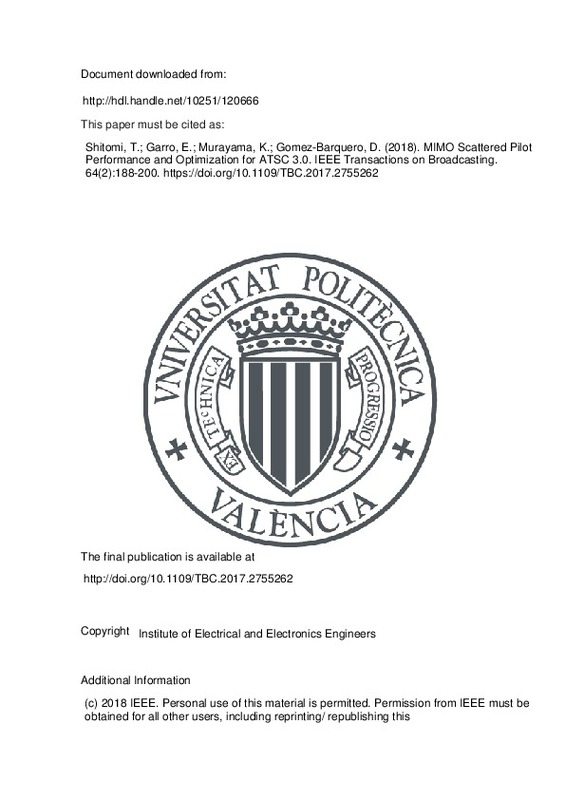JavaScript is disabled for your browser. Some features of this site may not work without it.
Buscar en RiuNet
Listar
Mi cuenta
Estadísticas
Ayuda RiuNet
Admin. UPV
MIMO Scattered Pilot Performance and Optimization for ATSC 3.0
Mostrar el registro sencillo del ítem
Ficheros en el ítem
| dc.contributor.author | Shitomi, Takuya
|
es_ES |
| dc.contributor.author | Garro, Eduardo
|
es_ES |
| dc.contributor.author | Murayama, Kenichi
|
es_ES |
| dc.contributor.author | Gomez-Barquero, David
|
es_ES |
| dc.date.accessioned | 2019-05-18T20:38:52Z | |
| dc.date.available | 2019-05-18T20:38:52Z | |
| dc.date.issued | 2018 | es_ES |
| dc.identifier.issn | 0018-9316 | es_ES |
| dc.identifier.uri | http://hdl.handle.net/10251/120666 | |
| dc.description | (c) 2018 IEEE. Personal use of this material is permitted. Permission from IEEE must be obtained for all other users, including reprinting/ republishing this | |
| dc.description.abstract | [EN] ATSC 3.0 is the latest digital terrestrial television (DTT) standard, and it allows a higher spectral efficiency and/or a transmission robustness with multiple-input multiple-output (MIMO) technology compared to existing DTT standards. Regarding MIMO channel estimation, two pilot encoding algorithms known as Walsh-Hadamard encoding and Null Pilot encoding are possible in ATSC 3.0. The two MIMO pilot algorithms are standardized so as to have the same pilot positions and the same pilot boosting as single-input single-output, and the optimum pilot configuration has not been fully evaluated for MIMO. This paper focuses on the performance evaluation and optimization of the pilot boosting and the pilot patterns for two MIMO pilot encoding algorithms in ATSC 3.0 using physical layer simulations. This paper provides a great benefit to broadcasters to select the MIMO pilot configuration including pilot boosting, pilot pattern, and pilot encoding algorithm that better suits their service requirements. Several channel interpolation algorithms have been taken into account as a typical receiver implementation in both fixed SFN reception and mobile reception. | es_ES |
| dc.description.sponsorship | This work was supported in part by the Ministry of Economy and Competitiveness of Spain under Grant TEC2014-56483-R, and in part by the European FEDER Fund. | es_ES |
| dc.language | Inglés | es_ES |
| dc.publisher | Institute of Electrical and Electronics Engineers | es_ES |
| dc.relation.ispartof | IEEE Transactions on Broadcasting | es_ES |
| dc.rights | Reserva de todos los derechos | es_ES |
| dc.subject | ATSC 3.0 | es_ES |
| dc.subject | Terrestrial broadcasting | es_ES |
| dc.subject | MIMO | es_ES |
| dc.subject | Channel estimation | es_ES |
| dc.subject | Pilot pattern | es_ES |
| dc.subject.classification | TEORIA DE LA SEÑAL Y COMUNICACIONES | es_ES |
| dc.title | MIMO Scattered Pilot Performance and Optimization for ATSC 3.0 | es_ES |
| dc.type | Artículo | es_ES |
| dc.identifier.doi | 10.1109/TBC.2017.2755262 | es_ES |
| dc.relation.projectID | info:eu-repo/grantAgreement/MINECO//TEC2014-56483-R/ES/TECNOLOGIAS DE RADIODIFUSION DIGITAL EXTRA-TERRESTRES/ | es_ES |
| dc.rights.accessRights | Abierto | es_ES |
| dc.contributor.affiliation | Universitat Politècnica de València. Instituto Universitario de Telecomunicación y Aplicaciones Multimedia - Institut Universitari de Telecomunicacions i Aplicacions Multimèdia | es_ES |
| dc.contributor.affiliation | Universitat Politècnica de València. Departamento de Comunicaciones - Departament de Comunicacions | es_ES |
| dc.description.bibliographicCitation | Shitomi, T.; Garro, E.; Murayama, K.; Gomez-Barquero, D. (2018). MIMO Scattered Pilot Performance and Optimization for ATSC 3.0. IEEE Transactions on Broadcasting. 64(2):188-200. https://doi.org/10.1109/TBC.2017.2755262 | es_ES |
| dc.description.accrualMethod | S | es_ES |
| dc.relation.publisherversion | http://doi.org/10.1109/TBC.2017.2755262 | es_ES |
| dc.description.upvformatpinicio | 188 | es_ES |
| dc.description.upvformatpfin | 200 | es_ES |
| dc.type.version | info:eu-repo/semantics/publishedVersion | es_ES |
| dc.description.volume | 64 | es_ES |
| dc.description.issue | 2 | es_ES |
| dc.relation.pasarela | S\354728 | es_ES |
| dc.contributor.funder | Ministerio de Economía, Industria y Competitividad | es_ES |







![[Cerrado]](/themes/UPV/images/candado.png)

